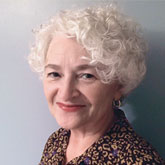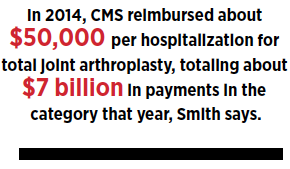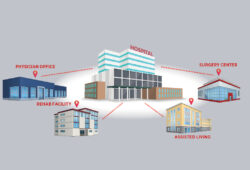A growing number of procedures qualify as outpatient, improving patient experience & reducing costs
Historically, improved technologies and increased physician proficiency at less-invasive techniques drove the migration of procedures to either outpatient departments or ambulatory surgical centers (ASCs). Today, payers and consumers are the main influencers for a mounting number of procedures moving to these settings. The result? Lower costs associated with patient care and less patient time in facilities.
In recent years, the Centers for Medicare & Medicaid Services (CMS) added a variety of procedures in the areas of orthopedics and cardiology to its payment schedule for hospital outpatient services and ASCs. For 2020, CMS has finalized the removal of total hip arthroplasty from the inpatient-only list, as well as allowed six cardiac interventional procedures to be performed at an ASC.

“Medicare is one of the main drivers, as it creates rules that allow this shift to happen,” explains Holly Moore, MSN, CCRN-K, a Clinical Director within the HealthTrust Clinical Services team. “CMS reviews quality, utilization and cost files annually and updates the inpatient, outpatient and ASC payment systems based on their findings, along with stakeholder expert opinions. What Medicare does, private insurers will typically follow.”
Joint replacements pegged

Total knee arthroplasty was removed from the inpatient-only list in 2018, and total hip arthroplasty has been finalized to soon follow. This shift in orthopedics seems logical, given that the length of hospital stay after joint replacement has shrunk to a point where some patients meet discharge criteria on the day of surgery, according to a 2018 paper in Acta Orthopaedica. This transition is largely due to a combination of organizational and medical improvements in pain and anesthetic use, quicker patient mobilization and tighter surgical protocols, says Kym Smith, RN, also a Clinical Director within the HealthTrust Clinical Services team.

For 2020, CMS has proposed reimbursement rates of $11,960 per total joint replacement surgery taking place in ASCs—more than $500 higher than the $11,419 for inpatient reimbursement.
“Of course, this shift will require some care coordination as well, and patient selection is important because these patients have to be fairly healthy, high-functioning and have low comorbidities for a same- day discharge,” says Smith. Patient selection processes must be in place for total joint arthroplasty in an ASC.
Cardiology procedures on the brink of change
In cardiology, six percutaneous coronary interventions (PCIs) have been cleared for ASCs in 2020. This ruling follows 17 diagnostic cardiac cath procedures added to the ASC list in 2019, a shift that CMS initiated in 2016 when pacemaker implants made the list, according to Cath Lab Digest.
“This allows individual consumers the flexibility to choose where they want to undergo their procedures, assuming it is safe to do so,” Moore says. “A patient’s comorbidities or chronic conditions and the specific procedure needed will be key determinants to patient selection for PCI in an ASC. Certain emergent situations—where the patient has suffered a heart attack, for instance—will continue to require hospitalization.”
Still, overall, the move to the ASC space is based on evidence that it’s a safe option. “CMS reported acceptable safety profiles for a specific subset of lower-risk cardiac patients and procedures,” Moore adds.
A smooth transition
More healthcare systems and individual physicians may partner to co-own ASCs, capitalizing on this trend, Moore explains. Doing so offers physicians the flexibility to perform procedures in various locations and prevents stakeholders from losing revenue. But providers must ensure continuity of care, Smith adds.
“Providers must ensure systems are in place to provide patients assistance in the immediate post-operative period to address questions and concerns, and minimize the potential for adverse events and hospital admissions,” Smith says.
Smith notes that it’s an educational shift for the patients, staff and providers. “It can be done safely, but patient selection is key.”
How is this shift impacting your organization? Share your story by contacting Executive Editor Faye Porter.
Share Email Q1 2020, Surgery





